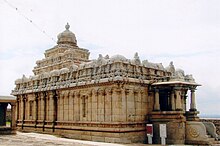
Back চাবুণ্ডরায় Bengali/Bangla चवुंडाराया Hindi ಚಾಮುಂಡರಾಯ Kannada Ćawundaraja Polish Chavundaraya Romanian Chavundaraya Serbo-Croatian சவுந்தராயா Tamil چامونڈ رائے Urdu
Chavundaraya | |
|---|---|
 | |
| Born | c. 940 CE |
| Died | 989 (aged 48–49) |
| Part of a series on |
| Jainism |
|---|
 |

Cāmuṇḍarāya or Chavundaraya (Kannada Cāmuṇḍarāya, Cāvuṇḍarāya, 940–989) was an Indian Jain ruler. He served in the court of the Western Ganga dynasty of Talakad (in modern Karnataka, India). A person of many talents, in 981 he commissioned the construction of the monolithic statue of Bahubali, the Gomateshwara, at Shravanabelagola, an important place of pilgrimage for Jainism. He was a devotee of the Jain Acharya Nemichandra and Ajitasena Bhattaraka and was an influential person during the reigns of Marasimha II Satyavakya, (963–975). Rachamalla IV Satyavakya, (975–986) and Rachamalla V (Rakkasaganga), (986–999).
A courageous commander with the title Samara Paraśurāma (lit, "Battle-Rama wielding an ax"), he found time to pursue his literary interests as well and became a renowned writer in Kannada and Sanskrit.[1][2] He wrote an important and existing prose piece called the Chavundaraya Purana, also known as Trishasthi Lakshana Purana, in Kannada (978) and the Cāritrasāra in Sanskrit. He patronised the famous Kannada grammarians Gunavarma and Nagavarma I and the poet Ranna whose writing Parusharama Charite may have been a eulogy of his patron.[1] Because of his many lasting contributions, Chavundaraya is an important figure in the history of medieval Karnataka.
© MMXXIII Rich X Search. We shall prevail. All rights reserved. Rich X Search